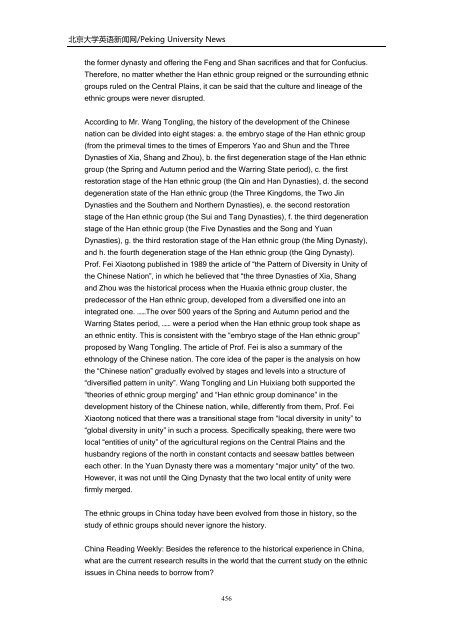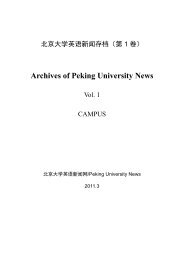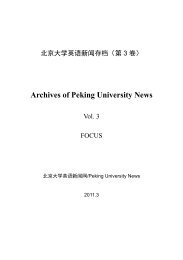Archives of Peking University News - PKU English - 北京大学
Archives of Peking University News - PKU English - 北京大学
Archives of Peking University News - PKU English - 北京大学
You also want an ePaper? Increase the reach of your titles
YUMPU automatically turns print PDFs into web optimized ePapers that Google loves.
<strong>北京大学</strong>英语新闻网/<strong>Peking</strong> <strong>University</strong> <strong>News</strong><br />
the former dynasty and <strong>of</strong>fering the Feng and Shan sacrifices and that for Confucius.<br />
Therefore, no matter whether the Han ethnic group reigned or the surrounding ethnic<br />
groups ruled on the Central Plains, it can be said that the culture and lineage <strong>of</strong> the<br />
ethnic groups were never disrupted.<br />
According to Mr. Wang Tongling, the history <strong>of</strong> the development <strong>of</strong> the Chinese<br />
nation can be divided into eight stages: a. the embryo stage <strong>of</strong> the Han ethnic group<br />
(from the primeval times to the times <strong>of</strong> Emperors Yao and Shun and the Three<br />
Dynasties <strong>of</strong> Xia, Shang and Zhou), b. the first degeneration stage <strong>of</strong> the Han ethnic<br />
group (the Spring and Autumn period and the Warring State period), c. the first<br />
restoration stage <strong>of</strong> the Han ethnic group (the Qin and Han Dynasties), d. the second<br />
degeneration state <strong>of</strong> the Han ethnic group (the Three Kingdoms, the Two Jin<br />
Dynasties and the Southern and Northern Dynasties), e. the second restoration<br />
stage <strong>of</strong> the Han ethnic group (the Sui and Tang Dynasties), f. the third degeneration<br />
stage <strong>of</strong> the Han ethnic group (the Five Dynasties and the Song and Yuan<br />
Dynasties), g. the third restoration stage <strong>of</strong> the Han ethnic group (the Ming Dynasty),<br />
and h. the fourth degeneration stage <strong>of</strong> the Han ethnic group (the Qing Dynasty).<br />
Pr<strong>of</strong>. Fei Xiaotong published in 1989 the article <strong>of</strong> ―the Pattern <strong>of</strong> Diversity in Unity <strong>of</strong><br />
the Chinese Nation‖, in which he believed that ―the three Dynasties <strong>of</strong> Xia, Shang<br />
and Zhou was the historical process when the Huaxia ethnic group cluster, the<br />
predecessor <strong>of</strong> the Han ethnic group, developed from a diversified one into an<br />
integrated one. ……The over 500 years <strong>of</strong> the Spring and Autumn period and the<br />
Warring States period, …… were a period when the Han ethnic group took shape as<br />
an ethnic entity. This is consistent with the ―embryo stage <strong>of</strong> the Han ethnic group‖<br />
proposed by Wang Tongling. The article <strong>of</strong> Pr<strong>of</strong>. Fei is also a summary <strong>of</strong> the<br />
ethnology <strong>of</strong> the Chinese nation. The core idea <strong>of</strong> the paper is the analysis on how<br />
the ―Chinese nation‖ gradually evolved by stages and levels into a structure <strong>of</strong><br />
―diversified pattern in unity‖. Wang Tongling and Lin Huixiang both supported the<br />
―theories <strong>of</strong> ethnic group merging‖ and ―Han ethnic group dominance‖ in the<br />
development history <strong>of</strong> the Chinese nation, while, differently from them, Pr<strong>of</strong>. Fei<br />
Xiaotong noticed that there was a transitional stage from ―local diversity in unity‖ to<br />
―global diversity in unity‖ in such a process. Specifically speaking, there were two<br />
local ―entities <strong>of</strong> unity‖ <strong>of</strong> the agricultural regions on the Central Plains and the<br />
husbandry regions <strong>of</strong> the north in constant contacts and seesaw battles between<br />
each other. In the Yuan Dynasty there was a momentary ―major unity‖ <strong>of</strong> the two.<br />
However, it was not until the Qing Dynasty that the two local entity <strong>of</strong> unity were<br />
firmly merged.<br />
The ethnic groups in China today have been evolved from those in history, so the<br />
study <strong>of</strong> ethnic groups should never ignore the history.<br />
China Reading Weekly: Besides the reference to the historical experience in China,<br />
what are the current research results in the world that the current study on the ethnic<br />
issues in China needs to borrow from?<br />
456




